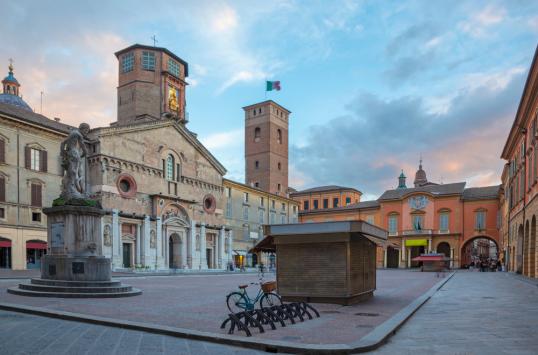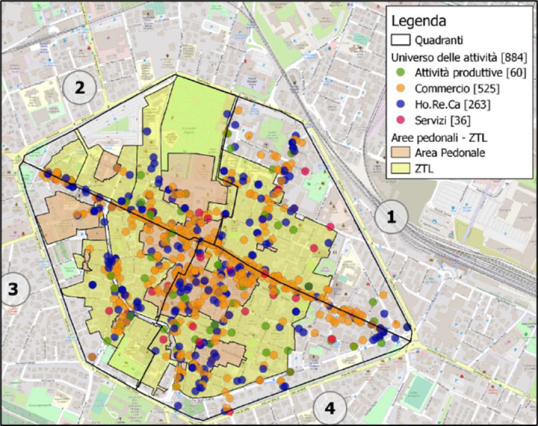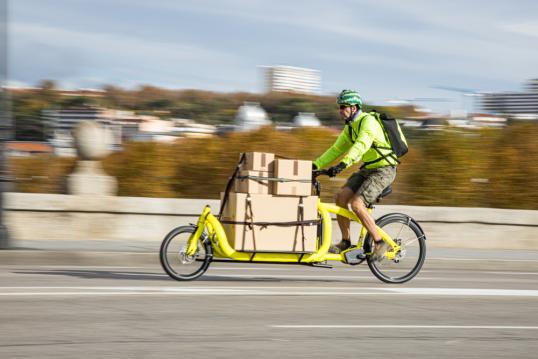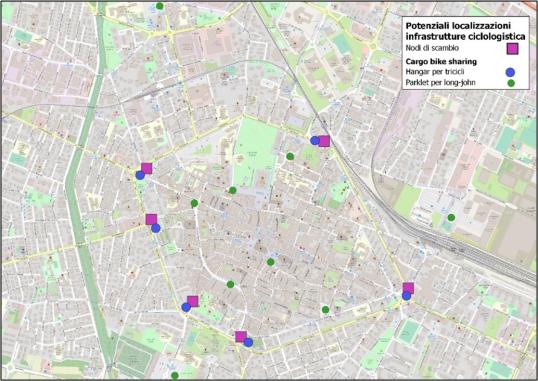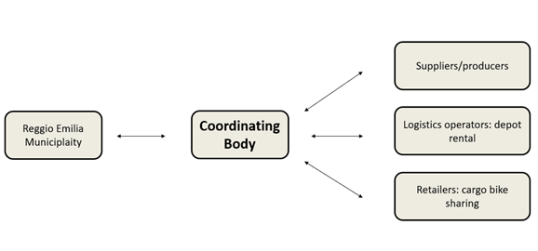- Topic
- Urban freight/city logistics
- Walking and cycling
- Country
- Italy
- Resource type
- Case study
First published 27 November 2023
Urban Freight Transport (UFT) and Last Mile Logistics (LML) are essential urban functions and bring economic gains, but they also contribute to the negative impacts that are associated with light-duty vehicles (LDVs) and motorised transport modes, posing social challenges due to outdated infrastructure, impacting small city centres' liveability.
Policymakers are promoting access regulations and clean vehicles for sustainable alternatives, as well as urban consolidation centres (UCCs) to optimise urban deliveries. However, the high number of permits that are often available to access a Limited Traffic Zone (LTZ) does not limit private motorised access significantly. The use of clean vehicles, and the electrification of fleets more generally, may reduce vehicles’ direct emissions without addressing accessibility, safety and global environmental issues, and UCCs face coordination challenges.
Cargo bikes offer a sustainable solution, capable of carrying significant loads (up to 300kg and 2 m3) with low energy consumption and cost. Thus tackling the inefficiencies of LCVs carrying, on average, 20-30% of their capacities (loads and volumes). Transitioning from vans to cargo bikes for CEP (courier, express and parcel) services, particularly in B2C (business-to-consumer) and C2C (customer-to-customer) segments could revolutionise urban logistics and mobility, improving its environmental and socio-economic performance, while at the same time addressing issues beyond transport, such as the use of energy and public space. However, they remain underutilised.
This case study presents the proposed strategic scheme for Reggio-Emilia (a small-sized Italian city), developed by TRT Trasporti e Territorio at the mandate of the city authority, targeting logistics operators, retailers, and households with tailored infrastructure, services, and governance coordination. Measures include on-street exchange nodes, cargo bike sharing and incentives for both retailers and households, coordinated by a specified actor. These initiatives aim to diversify LML approaches and reduce reliance on traditional vehicles. Similarly, household incentives aim at encouraging mode shift toward cycling and reducing car dependency.
While these measures are not yet in effect, they promise cost-effective, diversified, and comprehensive alternatives to traditional LML systems. The case study calls for broader adoption of cargo bikes and cycle logistics to meet European, national and local carbon neutrality targets and accommodate growing e-commerce, providing a foundation for future research and policy development in the absence of an EU "Cycle Logistics Plan".
Context
UFT and LML have economic benefits but come with socio-environmental costs. Growing e-commerce and local deliveries exacerbate traffic issues and inequalities associated with diverse social and spatial accessibility (transport, services, land-use consumption). Indeed, Italy lacks a clear urban logistics framework regulating curb-side operations, e.g., frequent illegal parking. Urban cycling is a cost-effective, safe, and eco-friendly solution, ideal for short urban trips. Cargo bikes can shift transport from cars and light-duty vehicles (LDVs), benefiting logistics operators, retailers, and households. To promote this shift, an action plan for cargo bike integration in Reggio Emilia has been developed, which aligns with the EU’s goals for carbon neutrality and socio-environmental targets in city plans, aiming to consolidate and normalise the use of cargo bikes as part of the urban logistics and mobility mix.
Reggio-Emilia, an Italian municipality with 170,000 residents, suffers from high motorisation rates, similar to other urban areas in the country (650 cars per thousand people), but has a notable urban cycling modal share of 15-25%. The historic centre with a diameter of 1 km, known as "the hexagon," is regulated with a camera-enforced Limited Traffic Zone (LTZ) and has a pedestrian area protected by moving bollards. A study in 2020 identified 880 commerces, low levels of foot traffic, 75% of deliveries by logistics operators, and frequent small deliveries [1], with cargo bikes being among the top three desirable services for urban logistics. In addition, lack of street parking and the reduced accessibility for cars in the city centre are considered the most impacting problems in the delivery process [2].
(Figure 1. Commerces in Reggio-Emilia (production sites in green, commerces and shops in orange, Ho.Re.Ca. (hotel, restaurants, cafés) in blue, services in pink, LTZ in yellow, pedestrian area in light orange). Source: ITL Istituto Trasporti e Logistica – RESOLVE project funded by INTERREG)
Urban logistics criticalities and trends
To mitigate the adverse effects of UFT and LML, key practices among cities in Europe include:
- Urban Vehicle Access Regulations (UVARs): Stricter regulations are usually more effective in reducing negative traffic impacts, but alternatives to private freight motorised vehicles are often lacking. Limits can be based on user needs (e.g. residents), vehicle emissions or trip purpose (e.g. delivery of goods) allowing access in specified time windows.
- Urban Consolidation Centres (UCCs): While seen as an opportunity to optimise urban freight deliveries, UCCs face challenges in coordinating with logistics operators who resist being forced to outsource their deliveries and having to use shared facilities.
- LDV Fleet Electrification: Electrifying LDV fleets is vital. However, upgrading LDVs with newer engines does not address systemic problems and encourages oversized vehicle use. LDV electrification entails uncertain investments and dependence on energy and material availability, shifting issues from fossil fuels to other industries. Moreover, in sensitive areas cities aim at increasingly restricting the presence and use of motorised vehicles, regardless of fuel type.
In action
In line with the most common policy packages mentioned above (namely UVARs, UCCs and LDV fleet electrification), the Municipality of Reggio-Emilia already enforces limited vehicle access to its pedestrian area and LTZ with specific time windows [3] and permits issued based on residency, transport, and mobility needs. However, an excessive number of permits (24% of the population has a permit) results in frequent LDV parking in historic squares. The city has a strong cycling culture, with 23% of trips made by bicycle in 2015, supported by 280 km of cycle paths. Yet, infrastructure limitations and low awareness of the potential of cargo bikes hinders their integration within urban logistics and mobility. Only one shop in the city sells cargo bikes.
In addition, the analysis in Reggio-Emilia, which draws from a previous study on a UCC within the RESOLVE project, showed that implementing UCCs is challenging in terms of coordinating with logistics operators and financial sustainability. For these reasons, stakeholders in Reggio-Emilia rejected UCCs as a solution.
Overall, there is a general reference to urban logistics in the Sustainable Urban Mobility Plan (SUMP 2023) [4] and "Biciplan", but the municipality lacks specific urban logistics planning. As UFT and LML create negative effects due to dispersed, unoptimized services, mainly in Business to Business (B2B) and Business to Consumer (B2C) markets, a detailed strategy on sustainable urban logistics is needed. For instance, a study on urban freight transport in Milan reported that e-commerce constituted 6% by weight of the freight delivered, but 87% of deliveries [5].
Therefore, although these three common policy packages (UVARs, UCCs, and urban logistics fleet electrification) are widely implemented in many European cities, they only partly address the challenges related to UFT and LML. For these reasons, the case study of Reggio-Emilia proposes an innovative approach to urban logistics, aiming to overcome the challenges related to UVARs, UCCs and LDV fleet electrification.
Stakeholders’ engagement
In order to directly address its perceived limitations and inform stakeholders properly, the municipality of Reggio-Emilia decided to align the participatory process related to the "Cycle Logistics Plan" with the LTZ regulation update planned for 2024. External cycle logistics experts and cargo bike producers have been consulted to gather expert insights and reduce bias in assessing the proposal's technical aspects for goods delivery with cargo bikes.
Results
The proposed cycle logistics scheme presents a coordinated and integrated planning approach by promoting multi-modality, to address the challenges of UFT and LML by promoting cargo bikes in Reggio-Emilia. First, a package of integrated solutions has been defined addressing different potential users and usages. Secondly, specific micro-infrastructures, services and related policies have been designed to pair the different measures with the expected user. Thirdly, a governance scheme has been defined through a multilevel coordinating actor to monitor, promote and address users’ needs to give continuity to the plan for future upscaling.
- The targeted users are categorised as logistics operators, retailers, and households.
- The micro infrastructures, services and related policies are aggregated using on-street exchange nodes (of minimum dimensions 30 m2, 50 m2 or 100 m2; these are typically parking spaces that have been converted into loading/unloading areas furnished with autonomous containers to rent for logistics operators), cargo bike sharing for both retailers and households (on both an autonomous platform for retailers and on a community-owned basis for households), and cargo bike purchasing incentives.
- The multilevel coordinating actor will be selected by the municipality from actors with no conflict of interest with logistics services.
Figure 2. Proposed cycle logistics infrastructure and services (in purple the exchange nodes, in blue the hangars for three-wheeled bikes, and in green parklets for long-john cargo bikes).
In particular, it is proposed to:
- establish a "Cycle Logistics Partnership" to include logistic operators. The municipality, stakeholders, and a regulatory body could collaborate to promote cargo bikes. In particular, the coordinating/regulatory body would act independently on behalf of the Municipality, overseeing cycle logistics partnership operations, depot rentals, supplier connections, and promoting/monitoring the initiative. Parking spaces would be converted into urban depots/exchange nodes that offer rental opportunities for cargo bike storage, refrigeration, and charging infrastructure. Additionally, logistic operators would choose their cargo bike fleet.
- implement an autonomous cargo bike sharing scheme for retailers within the partnership. Hangar-based schemes offer stable, pedal-assisted three-wheel cargo bikes and include loading/unloading space for LDVs to facilitate cargo exchange.
- introduce a community cargo bike-sharing scheme through local associations and volunteers (households). Municipality-owned cargo bikes could be rented through urban cycling advocacy groups, with dedicated cargo bike parking replacing car parking spaces.
Figure 3. Stakeholders and management framework
In addition, the strategy proposes incentives, policies, and cycling infrastructure guidelines. Incentives would reward logistics operators based on the percentage of deliveries shifted from vans to cargo bikes, and subsidies would be provided to retailers and households for cargo bike purchases (this is already being offered by the municipality of Reggio-Emilia) [6].
Furthermore, the cycle logistics strategy calls for a revision of the LTZ and of the city centre access restrictions to discourage private motorised vehicle use, as well as the expansion of the pedestrian area.
Finally, the document emphasises the importance of ongoing monitoring, with both qualitative and quantitative metrics being used to assess the effectiveness of the cycle logistics scheme. Ex-ante and ex-post evaluation surveys, as well as data from LTZ cameras, could be used to gauge residents' perceptions and analyse the impact on deliveries and parcel types, allowing for necessary adjustments and continuous improvement of the strategy.
Challenges, opportunities and transferability
To date, the EU does not have an integrated “Cycle Logistics Scheme” for managing UFT. With the increase in e-commerce, UFT planning is crucial to reach the 2030 targets on carbon neutrality. The proposed cycle logistics strategy for Reggio-Emilia suggests comprehensive solutions to foster the spread of cargo bikes as one of the most effective tools to shift away from delivery vans and private motorised transport modes. The results are intended as a source for further research and scaling up among practitioners, academics, and policymakers.
The package of cycle logistics and cargo bike solutions proposed for the municipality of Reggio Emilia aims to pave the way towards an integrated approach. Although the proposed measures are not implemented yet, the following results are expected in the coming years:
- Cost and time-effective measures involving both autonomous and community services;
- A diversified approach to LML addressing different users and uses;
- Definition of a comprehensive alternative system in addition to the increased use of clean vehicles.
The Municipality of Reggio-Emilia has so far obtained funds of €245,000 from the GRETA tender (Greening Regional frEight Transport in fuAs) to start the first cargo bike operations through a pilot phase, with the realisation of an exchange micro-hub. Based on data collected during the testing phase, guidelines and recommendations will be developed aiming to further detail and develop the city’s cycle logistics strategy. Throughout the GRETA project, local stakeholders will be continuously involved to ensure fruitful collaboration. Results will be shared with neighbouring municipalities to set specific goals and measures for achieving low-carbon targets in a wider area.
[1] Studio sulla logistica urbana nel centro storico del Comune di Reggio Emilia, Fondazione Istituto Trasporti e Logistica, 2021
[3] The LTZ is accessible from 6.00 to 10.00 a.m. and from 2.00 to 4 p.m. from Monday to Friday.
[5] Zero Emission Urban Goods Transportation Programme, AMAT, Comune di Milano, Politecnico di Milano, 2023
In Depth
Websites:
https://www.comune.re.it/argomenti/mobilita/progetti/progetto-europeo-greta
https://aetransport.org/past-etc-papers/search-all-etc-conference-papers?abstractId=8103&state=b
Prague’s delivery bike depot named one of Europe’s top three zero-emission environmental projects - Prague, Czech Republic (expats.cz)(link is external) https://www.komodo.berlin/
For more specific, relevant information about the cycle logistics schemes in Reggio-Emilia, please contact:
- Edoardo Repetto, TRT Trasporti e Territorio: repetto
 trt [dot] it (repetto[at]trt[dot]it)
trt [dot] it (repetto[at]trt[dot]it) - Alberto Merigo, Comune di Reggio Emilia: alberto [dot] merigo
 comune [dot] re [dot] it (alberto[dot]merigo[at]comune[dot]re[dot]it)
comune [dot] re [dot] it (alberto[dot]merigo[at]comune[dot]re[dot]it)
Photo Credits: © Renata Sedmakova, David Fuentes Prieto- no permission to re-use image(s) without separate licence from Shutterstock.

